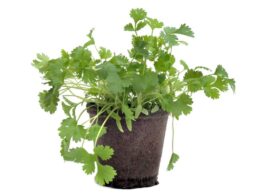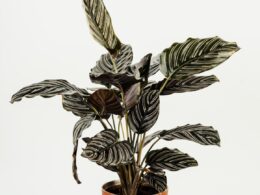What Is Catnip (Nepeta Cataria) and How Does It Work?
Before we get into the details of how to grow catnip, let’s learn a little about it. Catnip is a member of the mint family (Lamiaceae) and its scientific name is Nepeta cataria. This perennial herb is native to Europe and Asia, but it’s also naturalized in New Zealand and North America.
Catnip leaves and flowers contain nepetalactone, an organic compound that acts as a feline attractant. That’s because it simulates the effects of feline hormones. When cats smell catnip, they’ll often rub against it. Some may even eat it. Eating catnip can cause your kitty to feel relaxed or even drowsy.
If you want to grow some catnip for your own cat, you need to know that not all cats are affected by it. In fact, only about 50-70% of cats are responsive to catnip. So, if your cat doesn’t seem interested in the plant, don’t worry – there’s nothing wrong with them or your catnip.
Other Uses and Properties of Catnip
In addition to being a popular feline treat, catnip has a number of other uses. It can be used as an insect repellent, for example. And some people even use it in tea.
Catnip tea is said to have a soothing effect and can be helpful in treating colds, flu, and stomachaches. It can also be used as a mild sedative. If you want to try catnip tea, you can buy it online or at your local health food store.
How to Grow Catnip Indoors: Planting Catnip Seeds
How to grow catnip indoors from seeds? You can find catnip seeds at your local nursery or online. Once you have them, start them in flats or small pots filled with a potting mix. You can make it yourself by mixing perlite, peat and soil in equal amounts. Plant the seeds just under the surface of moistened soil.
Germination usually takes 2 weeks – after that time, you should see the seeds sprouting. Once the plants are big enough to handle, thin them out so that there is only one plant per pot. If you’re growing them in flats, wait for the seeds to germinate and transplant the seedlings to pots when they have two sets of true leaves.
How to Care for Catnip Once Planted
Once your catnip is planted, it’s important to water it regularly. The soil should be moist but not soggy, or your plants will start to rot. You can fertilize your catnip plants every few weeks with a liquid fertilizer or compost tea.
As the plant grows, you’ll need to pinch back the tips of the stems to encourage bushiness. You can also cut the plant back by half after it blooms (catnip produces white flowers, which are quite pretty, by the way) to encourage new growth.
Growing Catnip in a Garden – Dos and Don’ts
Catnip is hardy in USDA hardiness zones 3-9. If you want to replant catnip in your herb garden, wait until after the last frost has passed. Then, prepare the soil by loosening it with a shovel and raking out any stones or debris. You can then sow the catnip seeds directly into the soil, but containers are preferred. If you’re transplanting young plants, space them 18-24 inches apart.
Catnip plants prefer at least six hours of full sun per day, but will also grow in partial shade. They also like well-drained, fertile soil. Once your catnip plants are established, water them about once a week – more if the weather is hot and dry.
If you’re interested in how to grow catnip outdoors safely, here are a few things to be aware of:
- Avoid planting catnip close to decorative plants or vegetables – your garden will attract cats that may dig them up or trample them.
- If you have a neighborhood cat that likes to use your garden as a litter box, consider planting catnip in pots or containers at the edges of the garden.
- Catnip is invasive, just like mint, so be sure to plant it in an area where it can spread without causing problems. This is also the main reason for planting it in containers.
- Catnip flowers will attract honeybees and the leaves will repel pests like rats, mice, aphids or beetles. This makes it quite a useful plant to have in your garden!
Harvesting and Pruning Your Catnip
You can start harvesting your catnip plants when they’re about four to six weeks old. Cut the top few inches off the plant, being sure to leave some leaves behind. You can store dried leaves and stems for later use, or keep the foliage fresh in a vase. If you want to dry some fresh catnip, tie the stems together and hang them upside down in a dark, dry place.
Pruning your catnip plants will keep them from getting too leggy and will encourage new growth. Snip the stems back by about half at the end of the growing season.
Common Diseases Affecting Catnip Plants
The two most common diseases affecting catnip plants are root rot and powdery mildew. Root rot is caused by overwatering or planting in poorly-drained soil. If you do notice it, remove the affected plants from the soil and discard them.
Powdery mildew is a white, powdery fungus that can affect both indoor and outdoor plants. It’s most common in humid or wet conditions. The best way to prevent it is to make sure your catnip plants have plenty of air circulation and to water them at the base of the plant, rather than from above.
Catnip Plant Care Is Easy – Enjoy It With Your Cat
That’s everything you need to know about how to grow catnip. With a little care, you’ll have a plentiful crop of this herb in no time. And your cat will enjoy their fresh or dried catnip, unless they’re one of the unaffected felines! Thanks for reading and happy gardening.



















